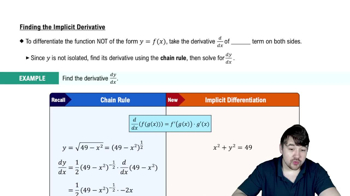Table of contents
- 0. Functions7h 52m
- Introduction to Functions16m
- Piecewise Functions10m
- Properties of Functions9m
- Common Functions1h 8m
- Transformations5m
- Combining Functions27m
- Exponent rules32m
- Exponential Functions28m
- Logarithmic Functions24m
- Properties of Logarithms34m
- Exponential & Logarithmic Equations35m
- Introduction to Trigonometric Functions38m
- Graphs of Trigonometric Functions44m
- Trigonometric Identities47m
- Inverse Trigonometric Functions48m
- 1. Limits and Continuity2h 2m
- 2. Intro to Derivatives1h 33m
- 3. Techniques of Differentiation3h 18m
- 4. Applications of Derivatives2h 38m
- 5. Graphical Applications of Derivatives6h 2m
- 6. Derivatives of Inverse, Exponential, & Logarithmic Functions2h 37m
- 7. Antiderivatives & Indefinite Integrals1h 26m
- 8. Definite Integrals3h 25m
4. Applications of Derivatives
Implicit Differentiation
Problem 3.8.84
Textbook Question
Orthogonal trajectories Two curves are orthogonal to each other if their tangent lines are perpendicular at each point of intersection (recall that two lines are perpendicular to each other if their slopes are negative reciprocals). A family of curves forms orthogonal trajectories with another family of curves if each curve in one family is orthogonal to each curve in the other family. For example, the parabolas y = cx² form orthogonal trajectories with the family of ellipses x²+2y² = k, where c and k are constants (see figure).
Find dy/dx for each equation of the following pairs. Use the derivatives to explain why the families of curves form orthogonal trajectories. <IMAGE>
y = cx²; x²+2y² = k, where c and k are constants
 Verified step by step guidance
Verified step by step guidance1
Differentiate the first equation y = cx² with respect to x to find dy/dx. Use the power rule for differentiation.
Differentiate the second equation x² + 2y² = k implicitly with respect to x. Remember to apply the chain rule for the term involving y.
Set the derivatives obtained from both equations equal to their respective slopes. The slope from the first equation will be dy/dx = 2cx, and from the second equation, solve for dy/dx after differentiating.
Determine the relationship between the slopes of the two curves. For orthogonal trajectories, the product of the slopes should equal -1, which means you need to check if (2cx) * (dy/dx from the second equation) = -1.
Conclude that if the product of the slopes is -1, then the curves are orthogonal at their points of intersection, confirming that the families of curves form orthogonal trajectories.
Recommended similar problem, with video answer:
 Verified Solution
Verified SolutionThis video solution was recommended by our tutors as helpful for the problem above
Video duration:
3mPlay a video:
Was this helpful?

 5:14m
5:14mWatch next
Master Finding The Implicit Derivative with a bite sized video explanation from Nick
Start learningRelated Videos
Related Practice



